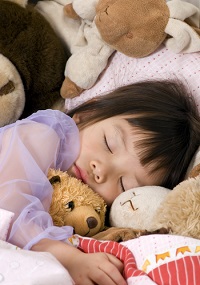 When supplying a favorite stuffed toy is the one, surefire way to get a fussy child to come down for a nap or a good night’s sleep, it almost seems like a no-brainer to hand it over as part of the bedtime routine. Still, it can be confusing to figure out whether or not encouraging your little one to rely on an object for comfort is a good idea. Before the age of one year, the American Academy of Pediatrics warns against introducing plush toys to your baby’s crib due to a potential increase in SIDS risk, but what about after she reaches that all-important one-year benchmark?
When supplying a favorite stuffed toy is the one, surefire way to get a fussy child to come down for a nap or a good night’s sleep, it almost seems like a no-brainer to hand it over as part of the bedtime routine. Still, it can be confusing to figure out whether or not encouraging your little one to rely on an object for comfort is a good idea. Before the age of one year, the American Academy of Pediatrics warns against introducing plush toys to your baby’s crib due to a potential increase in SIDS risk, but what about after she reaches that all-important one-year benchmark?
Understanding the Prevalence of Comfort Objects
A study conducted by researchers from both the University of Bristol in the United Kingdom and Yale University in the United States indicated that up to 70% of kids develop strong attachments to the comfort objects they rely upon to self-soothe. These transitional objects help babies learn to separate from their mothers with minimal trauma, and serve as important aspects of development for most kids. Special stuffed toys or blankies develop a very important role in kids’ lives, who tend to anthropomorphize their beloved stuffed animals in such a way that not even an exact replica of the toy is acceptable.
Are Comfort Objects Inherently Negative?
While some parents fixate on the idea of breaking their child from a dependency that they see as a weakness, there’s no real evidence that sleeping with a comfort object is emotionally damaging. Aside from the slight risk of allergen triggers from dusty or dirty plush toys, there’s very little risk at all when a child is old enough and has the requisite motor skills to move the object away from their face if breathing becomes difficult. A study at the University of Wisconsin at Milwaukee, originally intended to determine whether or not kids who have secure bonds with their mothers were more or less likely to rely upon comfort objects for sleep, found that there was no correlation at all between the strength of the parental bond or the lack thereof and use of a comfort object. The study also uncovered evidence that kids who were strongly attached to those objects seemed to more easily adjust to stressful situations when they had that object in their possession.
Making the Right Decision for Your Family
If your child is so attached to a comfort object that she refuses to go anywhere without it, problems can arise at the onset of the school year when school policies forbid such objects. Provided that a child is able to rely upon the object only in times of extreme duress or to self-soothe in order to sleep, there’s no real reason to forbid your child from bringing a favorite lovey to bed each night. Ultimately, the decision should depend upon the needs and lifestyle of your family and your own parenting style. If you feel that your child’s use of a comfort object has gone on for too long or that he’s getting too old to rely on such tactics, taking steps to gradually wean him away from a special stuffed animal may be in order. You should, however, expect for your child to regress in moments of extreme duress or dramatic transition. If he’s dealing with the loss of a loved one, a sudden and abrupt change in his life or another source of extreme anxiety, he may rediscover a need for the beloved animal that provided him with comfort before he was able to let go of that dependence.